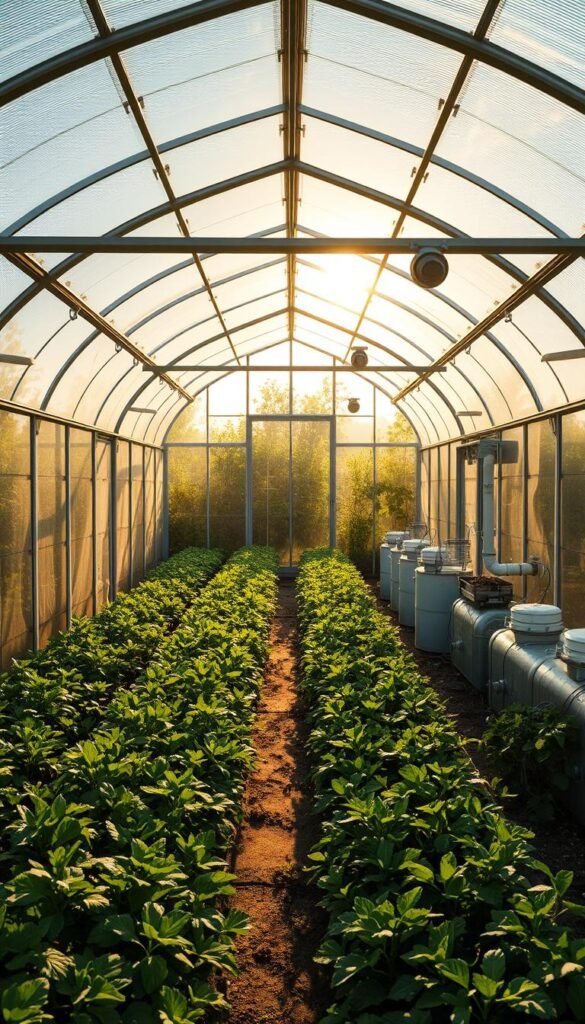Imagine growing fresh produce all year, even when snow blankets your backyard. Modern gardening solutions now let you harness nature’s power to create self-sufficient growing spaces that thrive in any season. These structures blend smart design with clean energy, offering a practical way to reduce reliance on traditional power sources while keeping plants healthy.
At their core, these innovative setups capture sunlight to maintain perfect growing conditions. They store heat during the day and release it at night, creating a stable microclimate that protects crops from frost or extreme heat. This approach not only cuts energy bills but also supports eco-friendly food production right at home.
You’ll find options ranging from simple backyard setups to advanced systems with solar panels and battery storage. Whether you’re a hobbyist or serious grower, these projects adapt to different needs and budgets. Many enthusiasts report noticeable savings within just a few growing seasons, along with the satisfaction of reducing their environmental impact.
As energy costs rise and climate concerns grow, more Americans are exploring this sustainable path. It’s not just about fresh tomatoes in January—it’s a step toward food security and responsible resource use. Let’s uncover how these structures work and why they’re changing how we think about home gardening.
Understanding Solar Greenhouses and Their Renewable Benefits
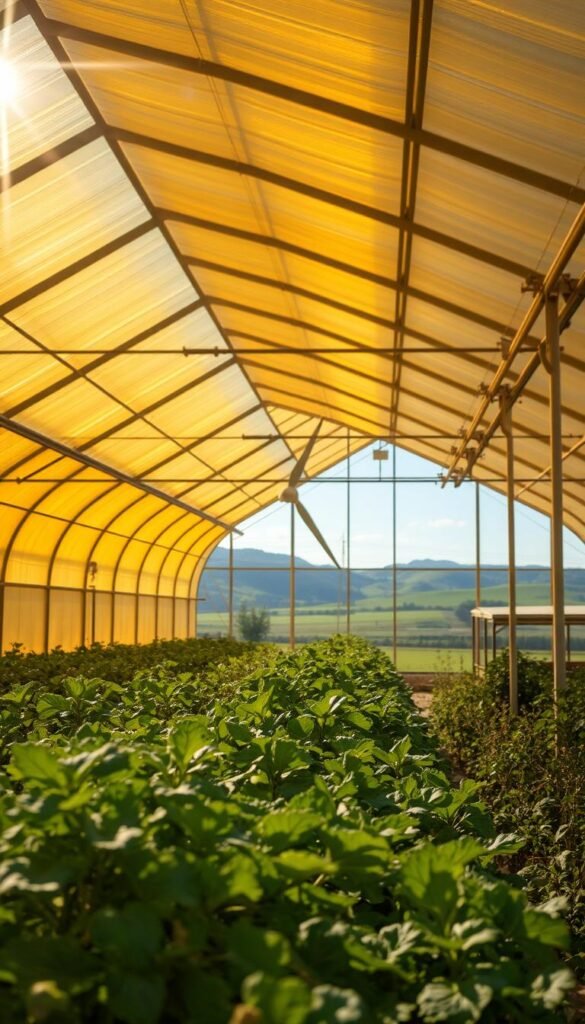
What if your garden thrived through every season, powered by sunlight? These innovative structures use smart design to turn natural resources into perfect growing conditions. Unlike traditional setups, they work with nature rather than against it.
What Is a Solar-Powered Greenhouse?
A solar-powered structure captures sunlight through south-facing panels or glazing. This design maximizes daytime heat absorption while insulated north walls lock in warmth. Thermal mass materials like water barrels or stone floors store excess energy, releasing it when temperatures drop.
Key Benefits for Sustainable Gardening
These setups cut heating costs by up to 70% compared to conventional options. Government programs like the 30% federal tax credit make them affordable long-term investments. Battery backups keep systems running during outages, ensuring consistent plant growth.
| Feature | Traditional Greenhouse | Solar-Powered Version |
|---|---|---|
| Energy Source | Fossil fuels/grid power | Sunlight + storage |
| Winter Heating Cost | $500+/month | $0 (sun-powered) |
| Maintenance | High (fuel systems) | Low (annual checks) |
| Incentives | None | 30% tax credit |
For smaller-scale solutions, consider hoop houses with row covers to complement your main setup. Solar models adapt easily—add panels as your needs grow or connect them to home systems. They’re not just tools but partners in building a greener future.
Planning Your Solar Greenhouse Project
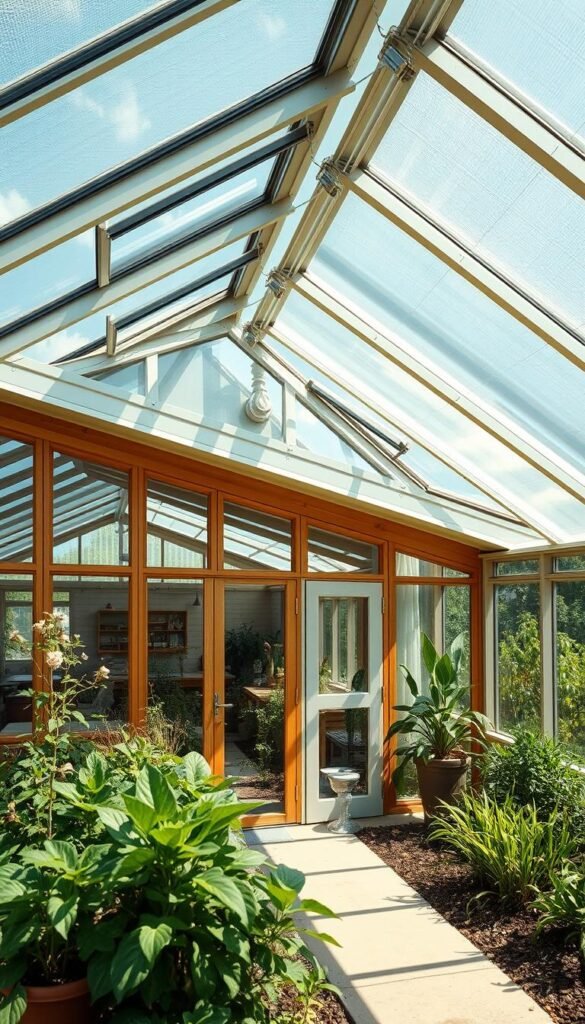
Crafting a space that harnesses nature’s rhythms starts with understanding your environment. Before breaking ground, you’ll want to map out how sunlight dances across your property and where cold air settles. This groundwork ensures your greenhouse design works with local weather patterns rather than fighting them.
Assessing Your Space and Environmental Needs
Begin by tracking sun exposure across potential sites. Southern-facing areas with minimal shade deliver maximum light capture—critical for winter growth. Note wind patterns too; a sheltered spot reduces heat loss. “Proper placement can slash heating needs by half,” notes Colorado State University’s horticulture team.
Next, calculate energy demands. List every system requiring power: grow lights, ventilation fans, water pumps. Multiply each device’s wattage by daily runtime hours. This total determines your solar panel capacity. Don’t forget seasonal climate shifts—size your system to handle January’s short days and July’s cooling demands.
Essential Materials and Tools for Construction
Choose glazing materials like tempered glass or polycarbonate for light diffusion. Insulate north walls with rigid foam or straw bales—these trap warmth without blocking light. For framing, cedar resists rot, while galvanized steel offers durability.
Keep these ideas in mind:
- Thermal mass containers (water barrels or stone beds) stabilize temperatures
- Ridge vents paired with base wall openings create natural airflow
- Local permits often require wind load calculations for permanent structures
Budget for unexpected costs—soil amendments or professional electrical checks might arise. With thoughtful preparation, your vision for fresh greens in December becomes achievable.
DIY Solar Greenhouses: Using Renewable Energy for Year-Round Growing
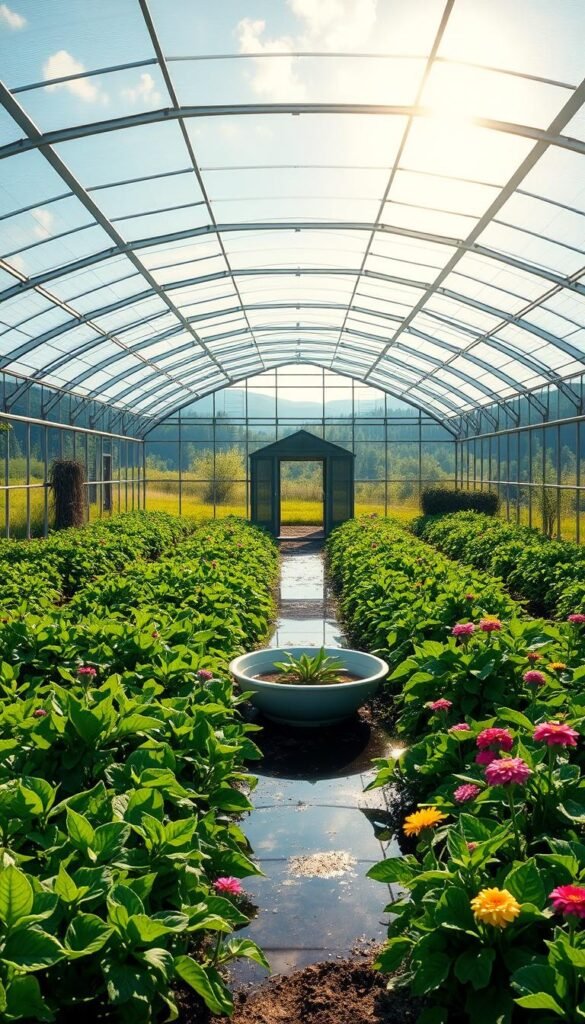
Creating a self-sustaining plant habitat combines smart construction with clean power integration. Let’s break down the process into manageable phases that balance structural integrity with smart energy use.
Step-by-Step Guide to Building Your Greenhouse
Start by preparing a level foundation—gravel beds work well for drainage. Assemble your frame using weather-resistant materials like galvanized steel. South-facing glazing should tilt at 30-45 degrees to catch low winter sun angles. This positioning captures 60% more light compared to vertical installations.
Insulate north walls with foam boards or recycled denim batting. These materials trap warmth while blocking icy winds. Install thermal mass containers like water-filled barrels along interior walls—they’ll absorb daytime heat and release it after sunset.
Incorporating Renewable Energy Systems
Choose solar panels based on your roof shape. Flexible models like EcoFlow’s bend around curved surfaces, while rigid panels suit flat roofs. Connect them to a solar generator through weatherproof cables. “A 400W system typically powers lights and a small water pump,” notes a recent energy efficiency study.
Wire panels to a charge controller first—this prevents battery overload. Link to deep-cycle batteries for night-time power, then connect an inverter for AC devices. Test each component separately before full integration. Seasonal adjustments ensure peak performance—clean panels monthly and check connections before winter storms.
Integrating Passive Solar Design and Thermal Mass
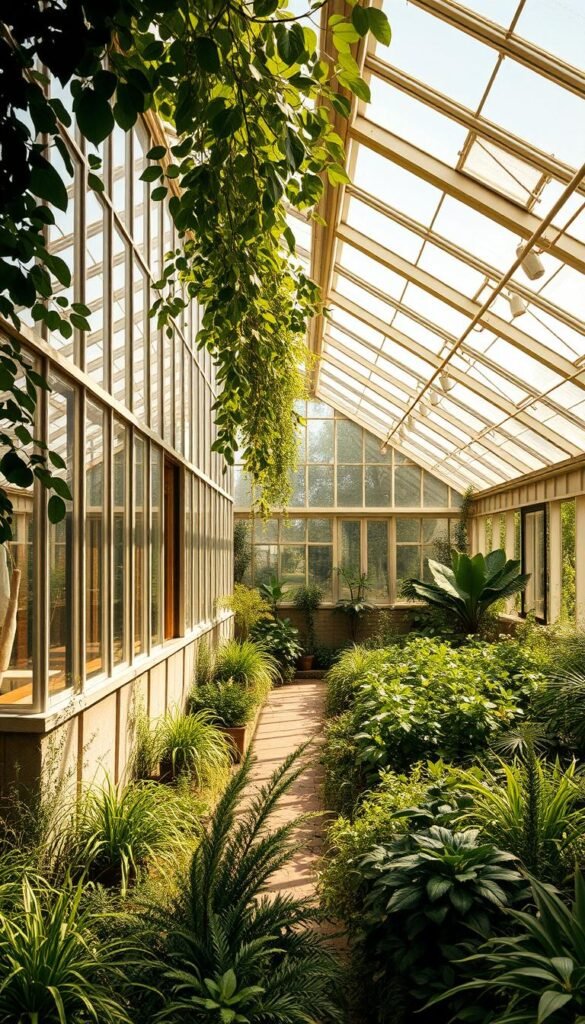
What keeps plants thriving when winter temperatures plummet? The answer lies in balancing sunlight capture with smart heat storage. By working with nature’s rhythms, you create a self-regulating system that maintains perfect growing conditions.
Principles of Passive Solar Design
Position your structure east-west with steep south-facing glazing. This setup grabs 73% more winter sunlight than vertical windows. North walls stay insulated to trap warmth, while vents at the ridge and base create natural airflow.
Deep winter models use underground storage. Fans push solar-heated air through buried pipes into rock beds. At night, this stored warmth rises back into the space. “Properly sized thermal mass can maintain 45°F when it’s -10°F outside,” notes a University of Minnesota study.
| Feature | Conventional Setup | Passive Solar Version |
|---|---|---|
| Orientation | Any direction | East-west alignment |
| Winter Heating | Electric/gas systems | Sun + thermal storage |
| Key Materials | Glass, metal frames | Water barrels, stone floors |
| January Performance | High energy use | Zero added fuel |
Using Thermal Mass for Consistent Heat Storage
Concrete floors and water containers are your best allies. Each gallon of water stores 8.3 BTUs—enough to warm 1 sq ft overnight. Dark-colored stone walls absorb midday rays, releasing heat gradually after sunset.
Calculate your needs: 3-4 gallons of water or 150 lbs of stone per square foot of glazing. This balance prevents summer overheating while ensuring winter warmth. Combine with Trombe walls—glass-fronted masonry panels—to boost efficiency by 40%.
“Thermal mass acts like a battery for solar energy, smoothing temperature swings better than any gadget.”
Remember to insulate north-facing surfaces thoroughly. This teamwork between heat capture and storage lets you grow citrus in Montana using less energy than a space heater.
Optimizing Solar Panel Placement and Energy Independence
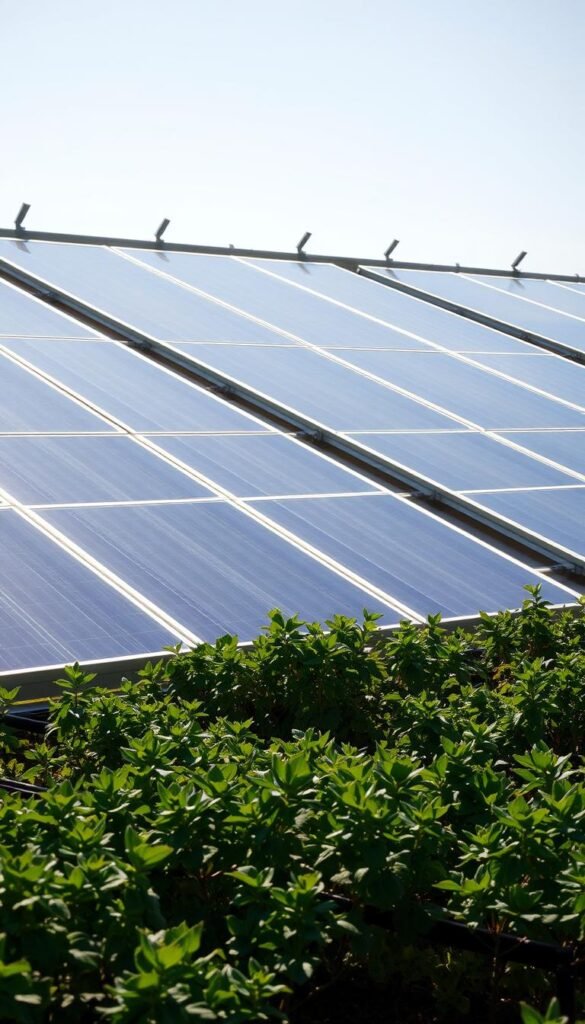
Proper positioning transforms sunlight into a reliable power source for your growing space. By aligning technology with nature’s patterns, you unlock consistent energy production that keeps systems running smoothly through every season.
Best Practices for Solar Panel Positioning and Efficiency
Angle matters more than you think. Set panels at your latitude plus 15 degrees for winter sun capture. Adjust to latitude minus 15 degrees in summer to prevent overheating. Tools like solar pathfinders map shade patterns from trees or buildings year-round.
South-facing installations grab 20% more light than other directions. Leave space between panels for snow shedding and airflow—critical for maintaining efficiency ratings in harsh weather. Regular cleaning (every 6 weeks) prevents dust buildup that can slash output by 15%.
Smart Engineering to Maximize Energy Savings
Micro-inverters boost performance when partial shading occurs. Pair them with tracking systems that follow the sun’s path—these can increase daily energy harvest by 25%. Battery banks store surplus power, while grid-tie setups let you sell excess energy back to utilities.
Consider bifacial panels that capture reflected light from greenhouse surfaces. Combined with real-time monitoring apps, these innovations help maintain optimal growing conditions without constant manual checks.
| Feature | Fixed Panels | Tracking Systems |
|---|---|---|
| Daily Output | 4-6 kWh | 5-7.5 kWh |
| Winter Performance | Good | Excellent |
| Maintenance Needs | Low | Moderate |
Advanced systems automatically adjust ventilation and lighting based on stored solar data. This smart integration reduces waste while pushing your setup closer to complete energy independence.
Real-World Applications and Case Studies in Solar Greenhouse Farming
Seeing sustainable solutions in action makes their benefits undeniable. Across continents, growers prove these systems work at various scales—from family farms to commercial operations. Let’s look at projects changing how we approach cold-weather cultivation.
Cold Climate Success Stories
The University of Minnesota teamed with five farms to test deep winter greenhouses. Locations like Owl Bluff Farm and Chelsea Morning Farm grew leafy greens at -20°F using only sunlight. Their secret? Strategic insulation and thermal mass that maintained 40°F nights without heaters.
These sites produced 1,200 lbs of brassicas and herbs monthly—enough to supply local markets year-round. One farmer noted, “We harvest spinach in January while reducing our energy costs by 80%.”
Global Innovations in Structure
China’s approach shows scalability. Their Q235 steel-framed designs withstand heavy snow and winds through reinforced tie rods. This engineering supports acres of tomatoes and peppers in regions with harsh winters.
Both models prove smart greenhouse design adapts to local challenges. Whether you’re growing sprouts or strawberries, these case studies offer blueprints for efficient food production in any climate.

